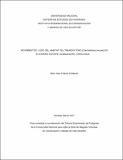| dc.contributor.author | Chávez Calderón, Elpìs | |
| dc.date.accessioned | 2017-09-08T16:44:45Z | |
| dc.date.available | 2017-09-08T16:44:45Z | |
| dc.date.created | 2017-09-08 | |
| dc.date.issued | 2017 | |
| dc.identifier.citation | Chávez-Calderón, E. (2017). Movimientos y uso del hábitat del tiburón toro (Carcharhinus leucas) en el estero Coyote, Guanacaste, Costa Rica, (Tesis de Maestría en Conservación y Manejo de Vida Silvestre). Universidad Nacional. | es_ES |
| dc.identifier.uri | http://hdl.handle.net/11056/14039 | |
| dc.description.abstract | El tiburón toro (Carcharhinus leucas) es una especie costera que tiene una gran afinidad
por ambientes estuarinos (ríos, manglares y humedales) durante las etapas tempranas de su
vida. El uso de hábitat y los patrones de movimiento de los tiburones toro juveniles en dichos
ecosistemas costeros puede ser el resultado de la tolerancia fisiológica a las condiciones
ambientales, así como al bajo riesgo de depredación y la disponibilidad de presas que hay en
estos ambientes. Se examinó la influencia de los factores ambientales sobre los movimientos
y la presencia de los tiburones toro juveniles en el estero Coyote, ubicado en el Pacífico norte
de Costa Rica. Los patrones de movimiento, actividad y uso del hábitat de tiburones toro
juveniles fueron analizados mediante el uso de telemetría acústica. Se colocaron dos
receptores dentro del estero y uno frente a desembocadura del estero para monitorear los
patrones de residencia y uso del hábitat en el área de estudio. Se marcaron seis tiburones toro
dentro del estero y se monitorearon por periodos de 5 - 146 días. Todos los tiburones
presentaron una alta residencia (IR > 0.5) y fidelidad al sitio (˂100 m). Los juveniles de tiburón
toro utilizaron cerca del 70% del área del estero y se encontraron en zonas con salinidades de
5 – 34 ppt, temperaturas de 27,2 - 32,3 °C y profundidades de 0,6 - 13,3 m. Ni el régimen de
mareas ni las fases lunares tuvieron un efecto evidente sobre la tasa de movimiento de los
tiburones toro. Los tiburones toro permanecieron dentro del estero todo el día, particularmente
durante las horas iluminadas del día y nadaron hacia la costa durante la noche. Se observó
un uso de profundidades someras durante el día y mayores durante la noche, lo cual puede
estar relacionado con un mayor éxito en la captura de sus presas y con la optimización de su
gasto energético. La variación en los patrones de movimiento y ámbito de hogar de los
tiburones toro en el estero Coyote en comparación con los observados en otros estudios
similares pueden deberse al tamaño y la ubicación del mismo, por lo que puede ser una
estrategia para optimizar su supervivencia en el sitio de estudio. Los resultados obtenidos
evidencian la conectividad entre el hábitat estuarino y costero, y resalta la importancia del
estero de Coyote para los estadios juveniles de tiburón toro. | es_ES |
| dc.description.abstract | The bull shark (Carcharhinus leucas) is a coastal species that has a high affinity
by estuarine environments (rivers, mangroves and wetlands) during the early stages of their
lifetime. Habitat use and movement patterns of juvenile bull sharks in these
coastal ecosystems may be the result of physiological tolerance to the conditions
environmental conditions, as well as the low risk of predation and the availability of prey in
these environments. The influence of environmental factors on movements was examined
and the presence of juvenile bull sharks in the Coyote estuary, located in the North Pacific
from Costa Rica. The patterns of movement, activity and habitat use of bull sharks
the minors were analyzed using acoustic telemetry. Two were placed
receivers within the estuary and one in front of the estuary mouth to monitor the
patterns of residence and habitat use in the study area. Six bull sharks were tagged
within the estuary and were monitored for periods of 5 - 146 days. All sharks
presented a high residence (IR> 0.5) and site fidelity (˂100 m). Juvenile shark
bull used about 70% of the estuary area and were found in areas with salinities of
5-34 ppt, temperatures of 27.2 - 32.3 ° C and depths of 0.6 - 13.3 m. Nor the regime
tides or moon phases had an obvious effect on the rate of movement of the
bull sharks. The bull sharks remained within the estuary all day, particularly
during the bright hours of the day and swam to shore at night. It is believed
use of shallow depths during the day and greater depths at night, which can
be related to greater success in capturing their prey and optimizing their
energy expenditure. The variation in the movement patterns and home environment of the
bull sharks in the Coyote estuary compared to those seen in other studies
similar may be due to the size and location of the same, so it may be a
strategy to optimize their survival at the study site. The results obtained
evidence the connectivity between estuarine and coastal habitats, and highlights the importance of
Coyote estuary for bull shark youth stadiums. | |
| dc.language.iso | es | es_ES |
| dc.publisher | Universidad Nacional (Costa Rica). Instituto Internacional en Conservación y Manejo de Vida Silvestre | es_ES |
| dc.subject | ECOSISTEMAS ACUÁTICOS | es_ES |
| dc.subject | TIBURÓN | es_ES |
| dc.subject | HÁBITAT | es_ES |
| dc.subject | CONSERVACIÓN DE LA VIDA SILVESTRE | es_ES |
| dc.subject | MANEJO DE VIDA SILVESTRE | es_ES |
| dc.title | Movimientos y uso del hábitat del tiburón toro (Carcharhinus leucas) en el estero Coyote, Guanacaste, Costa Rica | es_ES |
| dc.type | http://purl.org/coar/resource_type/c_bdcc | |
| bk-old-una.tipo | Maestría en Conservación y Manejo de Vida Silvestre | es_ES |
| una.tesis.numero | Tesis 9471 | es_ES |

